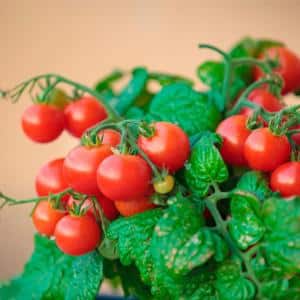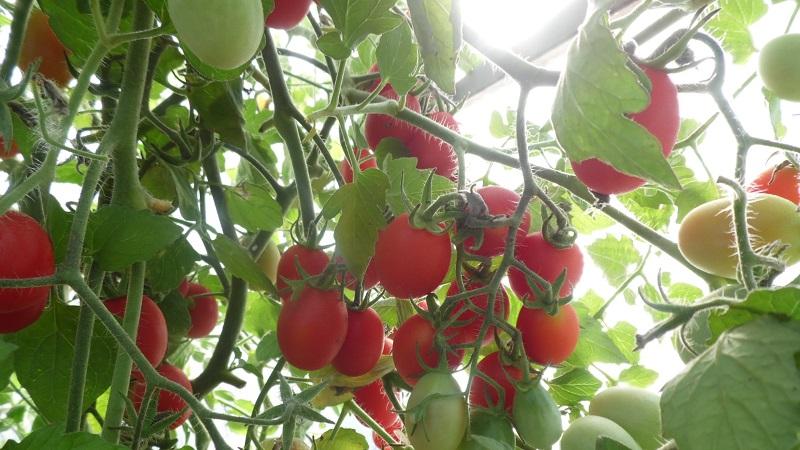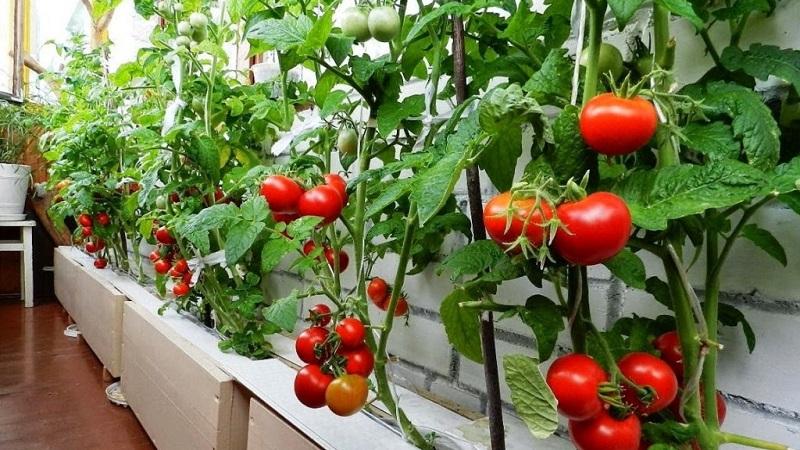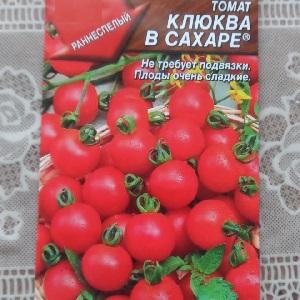A bright and tasty decoration for garden beds - tomato “Cranberry in Sugar”
Cranberry in sugar is not only a vitamin dish with berries, but also a high-yielding tomato variety. It is grown in vegetable gardens and greenhouses, as well as on the balcony at home. The miniature fruits have an unusual appearance and pleasant taste. Below we will talk about the characteristics of the variety and the secrets of agricultural technology that will help you get a rich harvest.
Description of the variety
The Cranberry tomato in sugar was bred by Russian breeders. The originator is the Aelita agricultural company.
Early ripening determinant a variety grown in a greenhouse, in open ground, in the fresh air in flowerpots and boxes, as well as at home. This variety combines small fruit with high yield.
The fruits are red, round in shape, smooth, with thick, glossy skin. Average weight - 12-15 g.
Growing seedlings
Regardless of the growing conditions (apartment window sill, greenhouse, open ground), the same agricultural technology is used. First you need to grow seedlings. Seeds are sown in the second decade of March.
Seed preparation
For better germination, seeds are soaked in a germination stimulator. During soaking, any seeds that float to the surface are discarded.
Important! When using a germination stimulator, strictly follow the instructions for the product. Excessive concentration or overexposure can lead to seed death.
Container and soil
Cranberry tomatoes in sugar need light but nutritious soil. You can use universal primers.The second option is to independently mix the substrate from fertile turf, humus and river sand in a ratio of 2:2:1.
It is recommended to sterilize the soil with heat or steam. Another option is to freeze it. Before planting seeds, the soil is moderately watered and leveled.
To grow seedlings, containers 7-8 cm deep are used.

Sowing
The seeds are placed in the grooves to a depth of 2-3 mm. The distance between the seeds is 3-4 cm. They are lightly sprinkled with peat or fine sand on top. They are slightly moistened with water at room temperature using a spray bottle.
Next, the containers are covered with glass or transparent film. Until sprouts appear, containers are kept in a dark place at a temperature of 25-27ºС. The soil should remain slightly moist. Once a day, the glass or film is removed for 10-15 minutes for ventilation.
Seedling care
When the seeds have sprouted, containers with seedlings are placed in the brightest and warmest place. In case of insufficient lighting, the crops are additionally illuminated with a phytolamp or a regular fluorescent lamp.
After two pairs of true leaves appear, the seedlings are picked and placed in separate pots (plastic and peat cups can be used). To avoid damaging the roots, the seedlings are dug up along with a lump of earth. To do this, use a wooden stick.
3-4 days after transplantation, the plants are fed with universal fertilizers for seedlings. Watering is done at least once a week.
Important! Water is poured along the edges of the pot, and not at the root. It should be warm.
At this stage, the air temperature can be reduced to 18ºC during the day and 15ºC at night.
Growing tomatoes
 Seedlings are planted in a permanent location in May. 50-60 days should pass from the moment the seeds are planted.If tomatoes will grow in open ground, then it should warm up to 10ºС at an outside air temperature of at least 15ºС. Before planting, it is recommended to harden the seedlings - take them outside for a short time.
Seedlings are planted in a permanent location in May. 50-60 days should pass from the moment the seeds are planted.If tomatoes will grow in open ground, then it should warm up to 10ºС at an outside air temperature of at least 15ºС. Before planting, it is recommended to harden the seedlings - take them outside for a short time.
Disembarkation time into the ground depends on the climate. Experienced gardeners often rely on folk signs - bird cherry blossoms and birch trees in full bloom.
It is recommended to spray the seedlings with a solution of boric acid: this reduces stress in the plant (1 g of acid per 1 liter of water).
They are planted in loamy soil. Wood ash and superphosphate are added to the hole under each plant. The distance between holes is 45 cm, between rows is at least 60 cm. It is recommended to plant plants in a checkerboard pattern.
Important! Tomatoes should not be planted in a bed where other nightshades have previously grown. Ideal “predecessors” are cucumbers, zucchini, onions, cabbage.
Care
Like other tomatoes, Cranberries in sugar require watering, loosening, fertilizing and weeding. Compact bushes of this variety do not require staking or pinching. Before flowering, tomatoes are watered moderately in the morning with warm water once a week. After the buds appear, the plants require more frequent watering.
Important! Drip preferred watering method. Water must not be poured under the roots!
Feeding is carried out once every two weeks. During growth, the tomato requires nitrogen-containing fertilizers, and after the appearance of ovaries and fruits - potassium and phosphorus.

Features of cultivation
Caring for this variety is usually not difficult. With proper agricultural technology, fruiting begins in July and continues until mid-September.
Diseases and pests
The variety is resistant to fusarium and late blight, but suffers from mosaic disease. This is a virus that disrupts the process of photosynthesis.Pale green dots appear on the leaves of the affected plant, which eventually turn into spots. The stems become brittle. Spots also appear on fruits.
The fight against mosaic disease lies in proper care of tomatoes. It is important to maintain optimal temperature and humidity, as well as regularly feed the plant, thereby strengthening its immunity. Infected bushes are removed from the garden bed and burned. The soil in their place is disinfected with a 2% solution of copper sulfate or a dark pink solution of potassium permanganate.
To avoid fungal diseases, during the growing season, plants are sprayed with a fungicide solution: copper sulfate, Bordeaux mixture or more modern means.
In greenhouses and apartments, tomatoes can be harmed by spider mites and aphids. Insecticides are used against them. Processing is carried out before the fruit begins to ripen.
Spraying the leaves with a 2-3% solution of ammonia saves the leaves from slugs.
Growing indoors
The characteristics of the variety allow you to get a good harvest in a greenhouse or at home.
In the greenhouse
If tomatoes are planted in a greenhouse, then the soil is first warmed up, since the temperature difference between the ground and air slows down the development of roots. Therefore, the soil is first watered with boiling water and covered with black film.
In the apartment
Tomatoes growing on a balcony or windowsill are more susceptible to disease and require more careful care. Before the buds bloom, the plant needs to be turned once every 3-5 days so that the bush forms evenly.
The ideal location for a home garden is a window on the south, southeast or southwest side. Otherwise, you will have to supplement the lighting with fluorescent or phytolamps, which are placed at a height of 25-30 cm from the top of the plant.It is recommended to artificially extend daylight hours to 14-16 hours.
Important! The volume of a pot or box for one plant is about 6 liters.
When grown at home, flowers require artificial pollination. To do this, the bushes are gently shaken several times throughout the day. Pollen can be transferred from one flower to another with a soft brush or feather.
Water homemade tomatoes with water at room temperature every 3-5 days. Always make sure that the soil does not dry out.
To prevent fungal diseases, the bush is sprayed with a weak solution of potassium permanganate about once every two weeks.

Harvesting and application
In a greenhouse, the yield reaches 3 kg per 1 sq. m.
The variety is universal in use — the fruits are eaten fresh, canned, pickled and used to decorate ready-made dishes.
Advantages of the variety and disadvantages
Among the advantages of the variety are the following:
- Low maintenance requirements. The plant adapts well to various conditions and is suitable for beginner gardeners.
- Determination. Upon reaching the genetically determined height, the growth of the bush stops.
- Standardity. The plant does not need pinching.
- Compactness. The height of the plant usually does not exceed 80 cm.
- Versatility. The variety is grown in regions with different climatic conditions.
- Disease resistance. Weakly susceptible to late blight and fungal diseases.
- Aesthetic appearance. A fruiting bush looks impressive on a window or balcony.
- Pleasant taste. Sugared cranberries have sweet fruits with a slight sourness.
The disadvantages include thick skin and sourness, but this is a matter of taste. Also, some note that in a greenhouse the bush can reach one and a half meters in height.
Farmer reviews
On the Internet there are different opinions from summer residents and gardeners about the Cranberry variety in sugar. Let's look at some of them.
 Natalia: “Because of the cold and fog, we had to harvest the crops unripe. I collected a large bucket from two bushes. The tomatoes ripened at home without any problems, but the taste was disappointing. And the skin is a bit thick. I don’t know yet whether I will plant Cranberries in sugar next year.”
Natalia: “Because of the cold and fog, we had to harvest the crops unripe. I collected a large bucket from two bushes. The tomatoes ripened at home without any problems, but the taste was disappointing. And the skin is a bit thick. I don’t know yet whether I will plant Cranberries in sugar next year.”
Lyudmila: “I planted it as an experiment on the windowsill and in the garden. The taste is not bad, but the skin is a bit tough. The kids liked it though. Overall the variety is very good. The yield in the garden and on the windowsill is approximately the same.”
Nicole: “Growing Cranberries in sugar is not difficult. In any case, no more difficult than other varieties. True, in the greenhouse the tomatoes grew almost as tall as me. Otherwise I was pleased: very sweet and good for canning.”
Conclusion
Sugared cranberries are an early-ripening variety that is suitable for growing by both experienced gardeners and beginners. It is versatile and can bear fruit in different conditions: in open ground, in a greenhouse, on a balcony and a windowsill.
The agricultural technology is the same as for growing other types of tomato. The variety is attractive not only for the taste of the fruit, but also for its appearance.